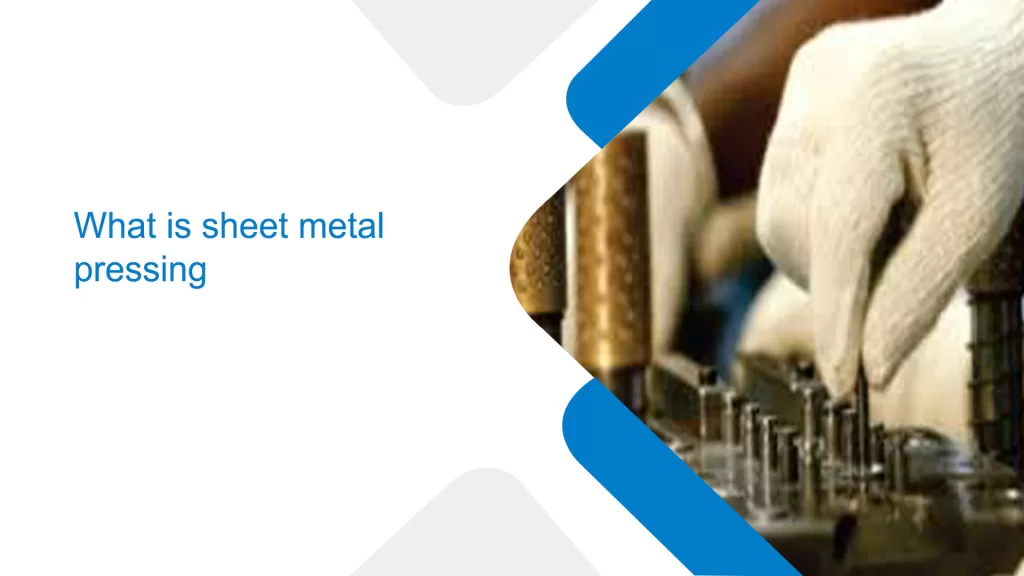What is sheet metal pressing?
- Sheet Metal |
- Aug 22, 2025

A press machine forms a flat sheet of metal into a given shape by putting a lot of pressure on it. Sheet metal pressing is what this is. This is one of the most prevalent ways to make metal because it is faster and cheaper than other ways.
You can obviously see the hood of their car or the dishwasher, which is definitely something that went through the sheet metal press process. This is something that manufacturers use all the time when they want to make sure that the parts they build are the appropriate size and of good quality.
You may get a lot of different metals at Sheet Metal Pressing, including steel, aluminium, copper, and brass. It can be utilised for a lot of various things and in a lot of different sectors. This process lets metals stretch and flex, which lets you form them in complicated ways. This makes it even more vital in the world of making things.
How does it work to press sheet metal?
In the metal stamping manufacturing process, the first step is putting a flat sheet of metal in a press machine.. The press has a specific die that operates like a mould. When the press is switched on, the die pushes on the sheet, which makes it take the shape of the die. The new part falls apart after the pressure is let go.
There are usually three main steps to press forming:
- Putting the material in: For small runs, the sheet is put into the press by hand. Automated feeders do it for big jobs.
- Pressing action: The press machine bends the metal into the shape of the die with a force that is precisely controlled.
- Ejection and finishing: The formed part is taken out and goes through a number of stages, such as trimming and polishing.
When parts are more sophisticated, this procedure may require a lot of steps in which a series of presses or a single press action shape the part in small amounts.
Different kinds of presses for sheet metal
There is a machine for every job, and the presses for sheet metals are created for specific tasks:
- Mechanical presses are useful for creating a lot of things at once because they have a motor and flywheels that help them make quick, repeated strokes.
- Hydraulic cylinders are what hydraulic presses utilise to move things. They are useful for working with heavy metals or particularly difficult parts since they can manage the force very well.
- Pneumatic presses are useful for jobs that need to be done rapidly. They employ pressurised air to operate with things that are not as heavy.
Typically, the type of metal, how thick it is, how much it can generate, and how complicated the design are what determine what kind of press to use. These presses are used by every major stamping manufacturer to create accurate parts for industries ranging from automotive to electronics
Benefits of pressing sheet metal
More and more people are preferring to press sheet steel because it is rapid, reliable, and adaptable:
- Very accurate — This approach lets you manufacture pieces that are of the same size and form, which makes it easy to put them together.
- Efficient — You can make large batches very quickly to fulfil the needs of the automotive and consumer electronics industries.
- This process works with a wide range of metals, from light aluminium to robust stainless steel.
- Cost-effective — Automated production uses fewer workers and materials, which makes production faster and cheaper.
- Strength and durability — Formed parts often have stronger structures, which makes them great for holding things.
What you can do with sheet metal pressing
Almost every big business uses press forming:
- Automotive parts include chassis brackets, car doors, hoods, and reinforcing panels.
- Washing machine drums, oven frames, refrigerator panels, and air conditioner housings are all appliances.
- Laptop cases, server racks, and coverings that protect electrical systems are all examples of electronics.
- Roof panels, metal cladding, window frames, and support beams are all parts of construction.
- Aerospace: The fuselages and interiors of aeroplanes need parts that are both strong and light.
The furniture sector even uses sheet steel pressing to manufacture metal cabinets, office chairs, and shelving units.
How to Choose the Right Press Forming Method
To create different metal parts, you need to use different procedures. You should consider about the following while choosing the correct sheet metal press method:
- Aluminium is easier to work with than stainless steel.
- Thickness: Hydraulic presses need to be stronger when they are working with thicker things, such sheets of metal.
- Complexity of the design: Complicated designs need more specialised dies and multi-step forming.
- Volume of production: For big production runs, machines are needed, but for short runs, people can accomplish it by hand.
For instance, manufacturing 500 identical steel brackets for use in industry would require a mechanical press and a specialised die. It would definitely take longer and require a more regulated hydraulic method to make limited-edition aluminium panels.
Just as with any other production process, there are challenges that come up when you press steel sheets. Some of these problems are:
- Tool wear: The die can get worn down over time, which can make it less precise.
- If you don’t take care of polished metals, they can get scratches and dents.
- Material springback: Some metals and alloys tend to go back to being flat. Some may need extra modifications after being pressed.
- Costs of setting up: Custom dies that cost a lot of money up front make it challenging for small-scale production to get going.
If you work with a competent expert and use high-quality materials, these problems might not be as bad.
Last thoughts
A metal sheet can be turned into a beautiful and useful portion that makes the end product better with the right equipment and methods. It’s crucial to recognise that pressing sheet metal is more than just bending or flattening it. It uses an approach that blends engineering with modern machines to get very precise results.
Things that are utilised every day are used in both the inside and outside of a luxury car and the parts of an aeroplane. Even if it is sensitive to time and accuracy, the way of combining speed and accuracy will still be employed for decades to come.




